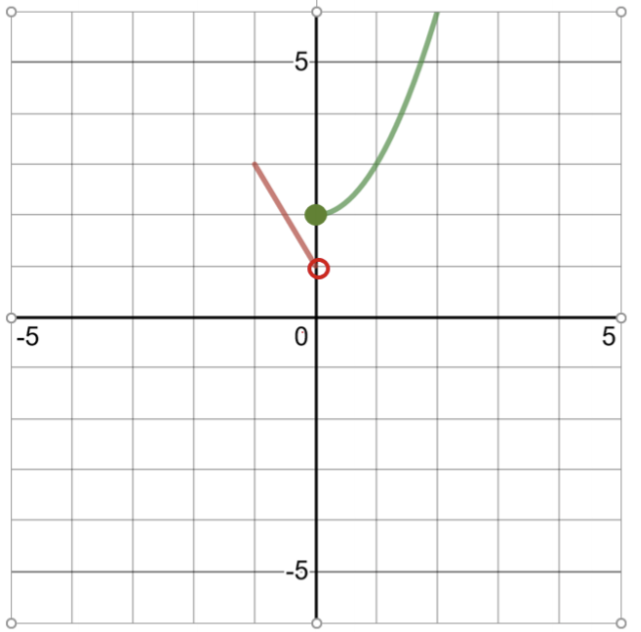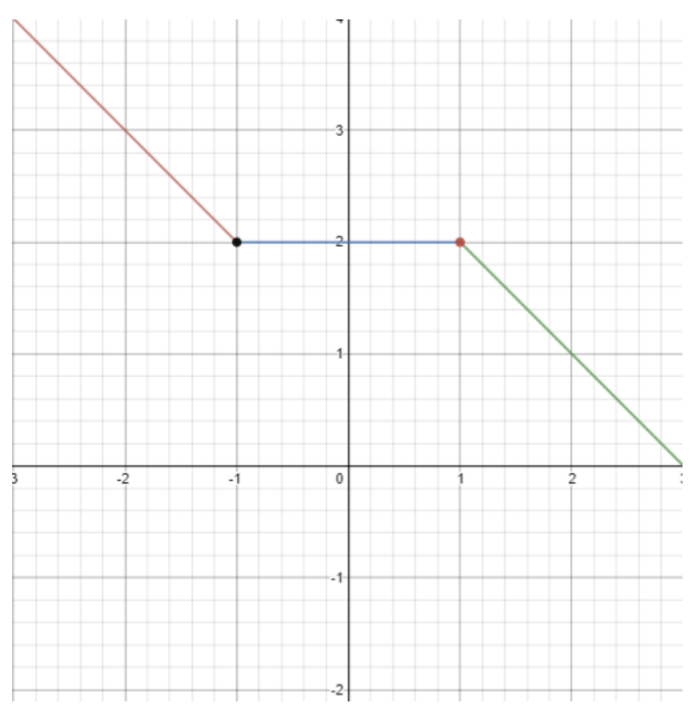4.11: टुकड़े-परिभाषा कार्य
- Page ID
- 168312
पीसवाइज़-डिफ़ाइंड फ़ंक्शंस वे फ़ंक्शन हैं जिन्हें डोमेन के विभिन्न हिस्सों के लिए अलग-अलग समीकरणों का उपयोग करके परिभाषित किया गया है।
दिए गए मानों के लिए निम्नलिखित टुकड़े-परिभाषित फ़ंक्शन का मूल्यांकन करें\(x\), और फ़ंक्शन को ग्राफ़ करें:
\(f(x) = \left\{\begin{array}{cc}−2x + 1 & −1 \leq x < 0 \\ x^2 + 2 &0 \leq x \leq 2\end{array} \right.\)
समाधान
इस फ़ंक्शन को ग्राफ़ करने के लिए, समाधानों की एक तालिका बनाएं:
|
के लिए समाधान तालिका\(f(x) = −2x + 1 \) डोमेन\(−1 \leq x < 0\) |
|
| \(x\) | \(f(x)\) |
| -1 | 3 |
| 0 | 1 (यहां सर्कल खोलें, 0 डोमेन में नहीं) |
|
के लिए समाधान तालिका\(f(x) = x^2 + 2\) डोमेन\(0 \leq x \leq 2\) |
|
| \(x\) | \(f(x)\) |
| 0 | दो |
| 1 | 3 |
| दो | 6 |

दिए गए मानों के लिए निम्नलिखित टुकड़े-परिभाषित फ़ंक्शन का मूल्यांकन करें\(x\), और फ़ंक्शन को ग्राफ़ करें:
\(f(x) = \left\{\begin{array}{cc} −x + 1 &x \leq −1 \\ 2 & −1 < x \leq 1 \\ −x + 3 &x > 1 \end{array}\right.\)
समाधान
इस फ़ंक्शन को ग्राफ़ करने के लिए, एक बार फिर समाधानों की एक तालिका बनाएं:
|
के लिए समाधान तालिका\(f(x) = −x + 1\) डोमेन\(x \leq −1\) |
|
| \(x\) | \(f(x)\) |
| -3 | 4 |
| -2 | 3 |
| -1 | 2 (यहां बंद सर्कल, -1 डोमेन में है) |
|
के लिए समाधान तालिका\(f(x) = 2\) डोमेन\(−1 < x \leq 1\) |
|
| \(x\) | \(f(x)\) |
| -1 | 2 (पिछले फ़ंक्शन द्वारा भरा गया ओपन सर्कल, -1 डोमेन में नहीं) |
| 0 | दो |
| 1 | 2 (यहां बंद सर्कल, 1 डोमेन में है) |
|
के लिए समाधान तालिका\(f(x) = −x + 3\) डोमेन\(x > 1\) |
|
| \(x\) | \(f(x)\) |
| 1 | 2 (पिछले फ़ंक्शन द्वारा भरा गया ओपन सर्कल, डोमेन में 1 नहीं) |
| दो | 1 |
| 3 | 0 |

x के दिए गए मानों के लिए निम्नलिखित टुकड़े-परिभाषित फ़ंक्शंस का मूल्यांकन करें, और फ़ंक्शंस को ग्राफ़ करें:।
- \ (f (x) =\ left\ {\ {\ {array} {cc}
x & x<0\\
2 x+1 &x\ geq 0
\ end {array}\ right.\) - \(g(x) = \left\{\begin{array}{cc} 4 − x& x < 2\\ 2x − 2 &x \geq 2 \end{array} \right.\)
- \(h(x) = \left\{\begin{array}{cc} −x − 1 & x < −1 \\ 0& −1 \leq x \leq 1 \\ x + 1 & x > 1 \end{array} \right.\)
- \(g(x) = \left\{\begin{array}{cc} 6 & −8 \leq x < −4 \\ 3 &−4 \leq x \leq 5 \end{array}\right.\)
- \(f(x) = \left\{\begin{array}{cc} −x + 1 & −1 \leq x < 1 \\ \sqrt{x − 1 } &1 \leq x \leq 5\end{array}\right.\)


